
A cocktail is a mixed drink, usually alcoholic. Most commonly, a cocktail is a combination of one or more spirits mixed with other ingredients, such as juices, flavored syrups, tonic water, shrubs, and bitters. Cocktails vary widely across regions of the world, and many websites publish both original recipes and their own interpretations of older and more famous cocktails.
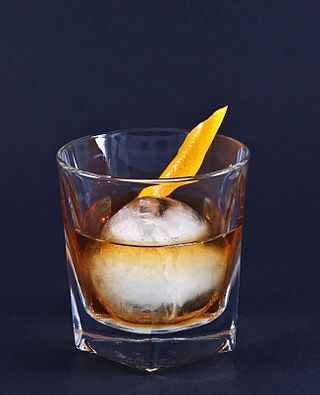
The old fashioned is a cocktail made by muddling sugar with bitters and water, adding whiskey or sometimes brandy, and garnishing with an orange slice or zest and a cocktail cherry. It is traditionally served with ice in an old fashioned glass.
Sour mix is a mixer that is yellow-green in color and is used in many cocktails. It is made from approximately equal parts lemon and/or lime juice and simple syrup and shaken vigorously with ice. This produces a pearly-white liquid with a pronounced flavor.
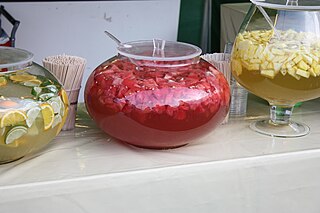
The term punch refers to a wide assortment of drinks, both non-alcoholic and alcoholic, generally containing fruits or fruit juice. The drink was introduced from the Indian subcontinent to England by employees of the East India Company in the late 17th century. Punch is usually served at parties in large, wide bowls, known as punch bowls.
Curaçao is a liqueur flavored with the dried peel of the bitter orange variety laraha, a citrus fruit grown on the Caribbean island of Curaçao.
Absinthiana is the paraphernalia surrounding the consumption of absinthe. Due to the bitter taste and high alcohol content of this drink, a need for dilution with water had led drinkers to a drinking ritual. Originally, absinthe was served in standard stemmed wine or water glasses and water was added from a simple carafe. But as its popularity grew so did the variety of implements used, such as specialty glasses and complex brouilleurs. Many 19th century companies used the elaborate barware to advertise their brands. Today, many contemporary distilleries are also producing decorative branded barware for the same purpose.

The Detroit Athletic Club is a private social club and athletic club located in the heart of Detroit's theater, sports, and entertainment district. It is located across the street from Detroit's historic Music Hall. The clubhouse was designed by Albert Kahn and inspired by Rome's Palazzo Farnese. It maintains reciprocal agreements for their members at other private clubs worldwide. It contains full-service athletic facilities, pools, restaurants, ballrooms, and guest rooms.
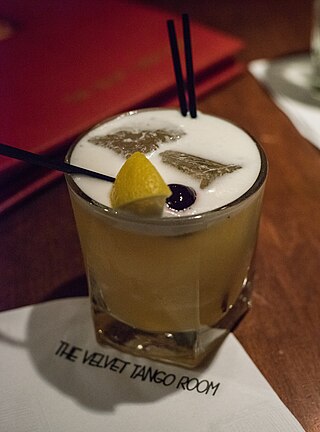
An amaretto sour is a cocktail using amaretto liqueur. It is a type of sour, a mixed drink made with a base spirit, citrus juice, and a sweetener. The drink is the most popular cocktail use for amaretto.

The Pimm's cup is a cocktail that is popular in England, in the United Kingdom. It is one of numerous fruit cups, a type of cocktail with gin, a soft drink, and fruit. Its primary spirit is Pimm's No. 1 Cup, a gin-based beverage flavoured with fruits and spices invented around 1823 as a health drink.
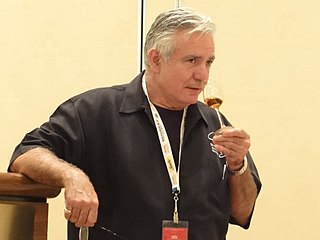
Dale DeGroff, also known as "the King of Cocktails" or "King Cocktail", is an American bartender and author. The New York Times in 2015 called DeGroff "one of the world's foremost cocktail experts", and wrote that his book The Craft of the Cocktail is considered an essential bartending reference. From 1987 to 1999 DeGroff rose to prominence as the original chief bartender in the Rainbow Room at Rockefeller Center in New York City, where his then-unusual emphasis on classic cocktail recipes and high-quality ingredients led to substantial acclaim and emulation by many other bars in New York City and beyond, and helped influence the creation of the craft cocktail movement.

Peychaud's bitters is a bitters distributed by the American Sazerac Company. It was originally created between 1849 and 1857 by Antoine Amédée Peychaud, a Creole apothecary from the French colony of Saint-Domingue who traveled to New Orleans, Louisiana, around 1793. It is a gentian-based bitters, comparable to Angostura bitters, but with a predominant anise aroma combined with a background of mint. It is currently produced at the Buffalo Trace Distillery in Frankfort, Kentucky.

Mr. Boston Official Bartender's Guide is a cocktail recipe book and bartending manual first published in 1935. The guide was once used on nearly every bar shelf in the United States. About 11 million copies were printed in 68 editions, as of 2015.
Tom Bullock (1872–1964) was an American bartender in the pre-Prohibition era. He was an African-American person.
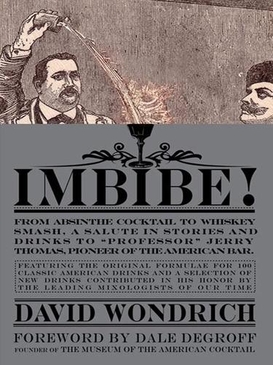
Imbibe! is a book by the cocktail historian David Wondrich. It was first published in November 2007 by Perigee Books.

The Aviary is a craft cocktail bar in Chicago, Illinois. The bar is part the Alinea Group, in of the same "culinary universe" as Alinea, run by Michelin-starred chef Grant Achatz.
Audrey Saunders is an American bartender, considered one of the world's most famous bartenders. She is most well known as the operating partner and creative lead of Pegu Club, a bar in New York City from 2005 to 2020. The bar was one of the most influential in the United States. Since its closure, Saunders and her husband have been developing a retreat for beverage industry members in rural Washington state.

The craft cocktail movement is a social movement spurred by the cocktail renaissance, a period of time in the late 20th and early 21st century characterized by a revival and re-prioritization of traditional recipes and methods in the bar industry, especially in the United States. The renaissance was followed by innovation and new techniques, and the movement has spread globally, now forming part of global cuisine.
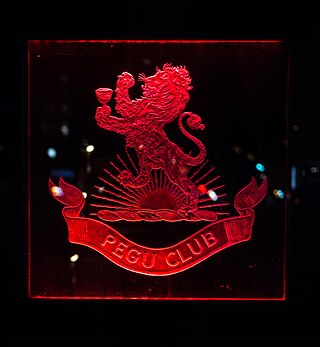
Pegu Club was a craft cocktail bar in New York City, operating from 2005 to 2020. It was located on the border of SoHo and Greenwich Village in Manhattan. The bar was named after and loosely inspired by the Pegu Club, a club in a British colonial outpost in Myanmar, as well as its signature cocktail with the same name.
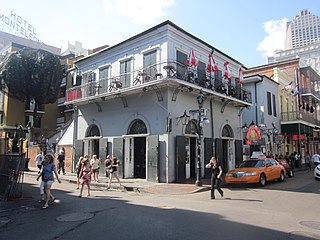
The Old Absinthe House is a historic building on Bourbon Street in the French Quarter of New Orleans, Louisiana.














